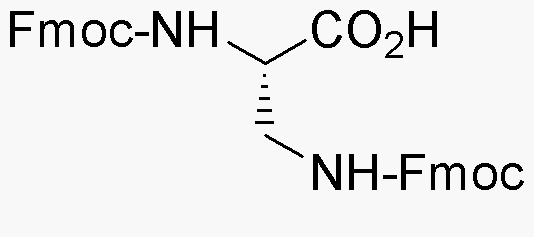Na,b-Bis-Fmoc-L-2,3-diaminopropionic acid is widely utilized in research focused on:
- Peptide Synthesis: This compound serves as a key building block in the synthesis of peptides, particularly in solid-phase peptide synthesis, allowing for the creation of complex peptide structures.
- Drug Development: It plays a crucial role in the development of pharmaceutical compounds, especially in designing peptide-based drugs that can target specific biological pathways.
- Bioconjugation: The chemical is used in bioconjugation processes, facilitating the attachment of biomolecules to surfaces or other molecules, which is essential in creating targeted therapies and diagnostics.
- Research in Neuroscience: It is applied in studies related to neuropeptides, aiding researchers in understanding neurological functions and developing treatments for neurodegenerative diseases.
- Custom Synthesis: This compound is valuable for custom synthesis projects in academic and industrial laboratories, providing flexibility in designing novel compounds for various applications.
Informations générales
Propriétés
Sécurité et réglementation
Applications
Na,b-Bis-Fmoc-L-2,3-diaminopropionic acid is widely utilized in research focused on:
- Peptide Synthesis: This compound serves as a key building block in the synthesis of peptides, particularly in solid-phase peptide synthesis, allowing for the creation of complex peptide structures.
- Drug Development: It plays a crucial role in the development of pharmaceutical compounds, especially in designing peptide-based drugs that can target specific biological pathways.
- Bioconjugation: The chemical is used in bioconjugation processes, facilitating the attachment of biomolecules to surfaces or other molecules, which is essential in creating targeted therapies and diagnostics.
- Research in Neuroscience: It is applied in studies related to neuropeptides, aiding researchers in understanding neurological functions and developing treatments for neurodegenerative diseases.
- Custom Synthesis: This compound is valuable for custom synthesis projects in academic and industrial laboratories, providing flexibility in designing novel compounds for various applications.
Documents
Fiches de données de sécurité (FDS)
La FDS fournit des informations de sécurité complètes sur la manipulation, le stockage et l’élimination du produit.
Spécifications du produit (PS)
Le PS fournit une description complète des propriétés du produit, notamment sa composition chimique, son état physique, sa pureté et les exigences de stockage. Il détaille également les plages de qualité acceptables et les applications prévues du produit.
Certificats d'analyse (COA)
Recherchez des certificats d'analyse (COA) en saisissant le numéro de lot du produit. Les numéros de lot et de lot se trouvent sur l'étiquette d'un produit, après les mots « Lot » ou « Lot de fabrication ».
Numéro de catalogue
Numéro de lot/série
Certificats d'origine (COO)
Ce certificat d'exploitation confirme le pays dans lequel le produit a été fabriqué, et détaille également les matériaux et composants utilisés et s'il est issu de sources naturelles, synthétiques ou autres sources spécifiques. Ce certificat peut être requis pour les douanes, le commerce et la conformité réglementaire.
Numéro de catalogue
Numéro de lot/série
Fiches de données de sécurité (FDS)
La FDS fournit des informations de sécurité complètes sur la manipulation, le stockage et l’élimination du produit.
DownloadSpécifications du produit (PS)
Le PS fournit une description complète des propriétés du produit, notamment sa composition chimique, son état physique, sa pureté et les exigences de stockage. Il détaille également les plages de qualité acceptables et les applications prévues du produit.
DownloadCertificats d'analyse (COA)
Recherchez des certificats d'analyse (COA) en saisissant le numéro de lot du produit. Les numéros de lot et de lot se trouvent sur l'étiquette d'un produit, après les mots « Lot » ou « Lot de fabrication ».
Numéro de catalogue
Numéro de lot/série
Certificats d'origine (COO)
Ce certificat d'exploitation confirme le pays dans lequel le produit a été fabriqué, et détaille également les matériaux et composants utilisés et s'il est issu de sources naturelles, synthétiques ou autres sources spécifiques. Ce certificat peut être requis pour les douanes, le commerce et la conformité réglementaire.


